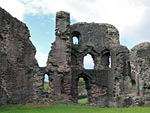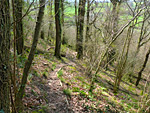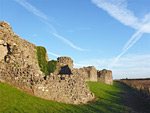Monmouthshire is one of the 13 ancient counties of Wales, and currently comprises about two thirds of its original size, after the 1974 transfer of the western section to five new, much smaller boroughs. The modern boundary of the county, or unitary authority, extends from Caldicot along a short section of the Bristol Channel, then follows the River Wye northwards, at one point incorporating a small area on the east side of the river, before moving northwest, past Monmouth to and a little beyond Llanthony in the Black Mountains, this the northernmost point. The western boundary of the country runs generally a short distance beyond the River Usk, coming close to Newport before veering southeast towards Caldicot and Chepstow.
Most of the land is rural, a mix of agricultural fields, small hills and winding valleys, with the most scenic areas being the Wye Valley in the east and the mountains of the far west. Monmouthshire contains a small section of the east side of Brecon Beacons National Park (most of which is in neighbouring Powys), including most of the Vale of Ewyas, and the isolated peak of Skirrd Fawr. Adjacent English counties are Gloucestershire to the east and Herefordshire to the north.
The landscapes are pretty, but Monmouthshire is perhaps best known for historic buildings, in particular its castles. Of the original 20 or so, nine are largely complete; four are found in city centres while the reminder have picturesque, rural settings. The relative abundance of castles is a consequence of the strategically important location, close to the historic boundary between Wales and England, which used to be a little further west of the current border; most of the forts were built by the English. The best castles are Chepstow, Raglan and White. Other noted antiquities include Caerwent Roman Town, which features extensive city walls up to 20 feet high, dating from the third century, and the beautiful monastic remains of Tintern Abbey and Llanthony Priory.
Most of the land is rural, a mix of agricultural fields, small hills and winding valleys, with the most scenic areas being the Wye Valley in the east and the mountains of the far west. Monmouthshire contains a small section of the east side of Brecon Beacons National Park (most of which is in neighbouring Powys), including most of the Vale of Ewyas, and the isolated peak of Skirrd Fawr. Adjacent English counties are Gloucestershire to the east and Herefordshire to the north.
The landscapes are pretty, but Monmouthshire is perhaps best known for historic buildings, in particular its castles. Of the original 20 or so, nine are largely complete; four are found in city centres while the reminder have picturesque, rural settings. The relative abundance of castles is a consequence of the strategically important location, close to the historic boundary between Wales and England, which used to be a little further west of the current border; most of the forts were built by the English. The best castles are Chepstow, Raglan and White. Other noted antiquities include Caerwent Roman Town, which features extensive city walls up to 20 feet high, dating from the third century, and the beautiful monastic remains of Tintern Abbey and Llanthony Priory.
CastlesAbergavenny Castle Town centre ruin with a long and varied history; surviving components include two towers, a gatehouse and part of the curtain walls Rating: ★★★★★ |
| Caldicot Castle Large Norman fortification, once a ruin but mostly restored in the 19th century, in a parkland setting surrounded by lawns and woods Rating: ★★★★★ |
| Chepstow Castle Large, well preserved and historically important Norman castle with a beautiful location overlooking the River Wye Rating: ★★★★★ |
| Grosmont Castle Compact, peaceful and picturesque castle near the River Monnow, surrounded by a dry moat Rating: ★★★★★ |
| Monmouth Castle Small castle in the city centre, birthplace of Henry V; now consists only of a great hall and a great tower Rating: ★★★★★ |
| Raglan Castle Spectacular, late medieval castle in the Wye Valley, complete with water-filled moat. Largely abandoned since the Civil War Rating: ★★★★★ |
| Skenfrith Castle Remains of a small 13th century castle, in rural surroundings overlooking the River Monnow: a circular keep, five towers and a curtain wall Rating: ★★★★★ |
| Usk Castle Ruins of a relatively small, privately-owned castle with pretty, wooded surroundings. The oldest sections are from the 12th century Rating: ★★★★★ |
| White Castle Norman castle with a large, walled outer court and a moated inner court, in a remote, rural setting Rating: ★★★★★ |
ChurchesPriory Church of St Mary, Chepstow Town centre parish church, mostly from the 18th and 19th centuries, but incorprating parts of a 12th century priory Rating: ★★★★★ |
| St Mary's Priory, Abergavenny Parish church originally built for a Benedictine priory, though greatly modified in Victorian times. Contains a number of elaborate medieval tombs Rating: ★★★★★ |
LandscapesBlorenge Flat-topped summit, high point of the hills south of Abergavenny, west of the River Usk. Reached by a 0.8 mile path Rating: ★★★★★ |
| Clydach Gorge Wooded valley containing a powerful river that forms several waterfalls and enclosed sections; also caves, old railway lines and industrial sites Rating: ★★★★★ |
| Skirrid Fawr Eastern outlier of the Brecon Beacons, circled by a 3.5 mile loop trail; overlooks a large area of south Wales Rating: ★★★★★ |
Nature Reserves, and similar placesBrockwells Meadows Four farm fields containing a good range of calcareous grassland plants, plus a few notable insect species; in a shallow valley near Caldicot Rating: ★★★★★ |
| Chepstow Park Wood Conifer plantation on elevated ground above the Wye valley; an ancient woodland site, once a royal hunting ground Rating: ★★★★★ |
| Dixton Embankment Calcareous grassland and woodland bordering the River Wye, with many summer wildflowers, especially orchids Rating: ★★★★★ |
| Magor Marsh Varied, easily accessible watery habitats on the Gwent Levels, including fen meadows, reens and a pond Rating: ★★★★★ |
| Margaret's Wood Steeply-sloping ancient woodland in the Whitebrook valley, west of the River Wye, including wild daffodils and two ruined buildings Rating: ★★★★★ |
| New Grove Meadows Four fields of species-rich grassland, lined by mature hedgerows, one of the finest wildflower meadows in the country Rating: ★★★★★ |
| Piercefield Woods Ancient woodland in the Wye Valley, on calcareous and acidic soils, plus saltmarsh along the river Rating: ★★★★★ |
| Priory Wood Ancient, mixed woodland on a steep slope above the River Usk, crossed by a 0.4 mile loop path Rating: ★★★★★ |
| Prisk Wood Ancient, atmospheric woodland on the steep slopes of the Wye Valley, crossed by small streams Rating: ★★★★★ |
| Springdale Farm Working farm with meadows, pasture, streams, boggy areas and ancient deciduous woodland Rating: ★★★★★ |
| Strawberry Cottage Wood Ancient oak woodland on a southwest-facing slope at the mouth of the Afon Honddu valley Rating: ★★★★★ |
| Wentwood Large, ancient woodland site, on high ground overlooking the valley of the River Usk; now mostly conifers Rating: ★★★★★ |
| Wyndcliff Limestone escarpment above the River Wye, with a spectacular viewpoint, Eagle's Nest Rating: ★★★★★ |
| The Wern Northeast-facing hillside with rough grassland, heath, scattered trees, millstone outcrops, and good views towards Monmouth Rating: ★★★★★ |
Roman SitesCaerwent Roman Town Relics from the Roman settlement of Venta Silurum, including a temple, forum, basilica, houses, and city walls up to 17 feet high Rating: ★★★★★ |
Ruined Abbeys, and other religious buildingsLlanthony Priory Ruined Augustinian priory in a remote location within the Black Mountains; dark, aged masonry and soaring Gothic arches Rating: ★★★★★ |
| Runston Chapel Roofless ruin of a small Norman chapel, in a rural location southwest of Chepstow Rating: ★★★★★ |
| Tintern Abbey Substantial, beautiful ruined abbey on the floor of the Wye Valley, beneath steep, forested slopes; established in the 12th century Rating: ★★★★★ |



































